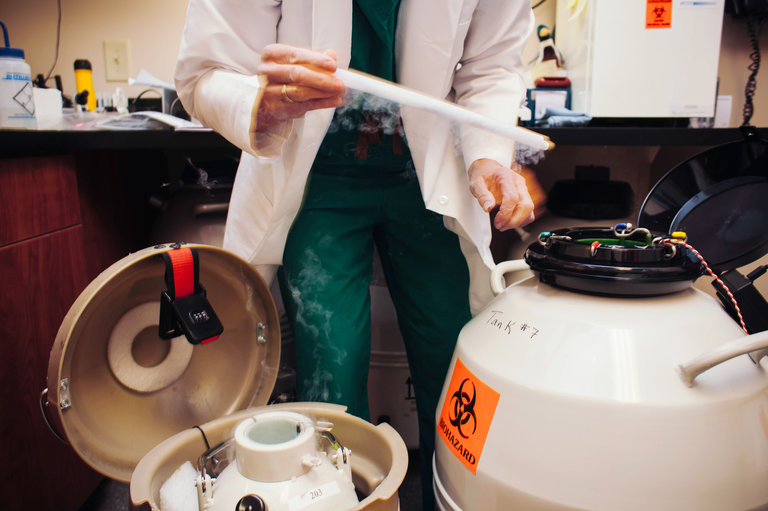
If you are new to the world of egg freezing, you might have discovered that there are are a number of technical terms associated with the process. As you research online, read testimonies, and consult with medical professional to decide if this is the right choice for you, it can help to have a grasp of the basics. So, in order to make the most of your research, we have compiled 11 terms to help you to navigate the world of egg freezing and fertility-lingo.
Social egg freezing refers to the practice of freezing a woman’s eggs for reasons that are not medically related. This decision is often made with the intention of postponing biological parenthood for professional or personal reasons.
2. Follicle
Follicles are pocket-like sacs located inside of the ovary that are responsible for the monthly maturation and release of an egg. In a typical menstrual cycle, only one follicle becomes dominant and releases an egg each month.
3. Superovulation
Superovulation occurs when a woman is given medication to stimulate her ovaries, causing the production of more than one follicle. In the context of egg freezing, stimulating the development of multiple follicles allows for the development and eventual retrieval of multiple eggs.
4. Trigger Shot
A trigger shot is an injection of synthetic human chorionic gonadotropin (hCG) hormone that is used to stimulate the maturation of eggs before an egg retrieval procedure.
5. Egg Retrieval
An egg retrieval procedure is an outpatient procedure where eggs are extracted from the ovaries for the purposes of egg freezing or in vitro fertilization (IVF).
6. Mature Egg
A mature egg is an egg is a follicle in the ovary that has undergone two rounds of cell division to reduce to 23 chromosomes, which is the number required for fertilization. During an egg retrieval procedure, not all eggs that are collected will be mature eggs. Only mature eggs are can be fertilized.
7. Ovarian Hyperstimulation Syndrome (OHSS)
Ovarian Hyperstimulation Syndrome (OHSS) occurs when the ovaries become irritated by injectable hormones taken to stimulate the growth of multiple follicles. The overstimulated ovaries swell, and the swelling produces fluid that seeps into the stomach causing stomach pain, bloating, and in some cases more severe reactions.
8. Vitrification
Egg vitrification is the process of dehydrating eggs with cryoprotectants and then placing them into liquid nitrogen for storage. Removing all of the water and freezing the eggs quickly helps to prevent the formation of ice crystals that can damage eggs.
9. Cryopreservation
Cryopreservation refers to the process of preserving biological matter by freezing it for future use. Egg freezing is a form of cryopreservation along with sperm and embryo freezing.
10. In Vitro Fertilization (IVF)
In vitro fertilization (IVF) is the multi-step process of collecting eggs, fertilizing them with sperm in a lab, growing any resulting embryos for up to 6 days, and either freezing for later use or transferring the most promising embryo(s) to a uterus, where it will hopefully implant within the uterine lining and lead to pregnancy. Women who choose to preserve their fertility through egg freezing can undergo IVF with their frozen eggs if and when biological parenthood is desired.
11. Intracytoplasmic Sperm Injection (ICSI)
Intracytoplasmic sperm injection (ICSI) is a procedure where fertilization is achieved by injecting a single, normal-appearing sperm directly into an egg. It is one of two possible methods of fertilization used during an in vitro fertilization (IVF) procedure. It is considered to be an effective method of fertilization and is generally used when there is a concern about the ability of sperm to fertilize an egg.
ABOUT GUEST CONTRIBUTOR
 Kelly Park is the founder of FertilitySmarts.com, an online destination dedicated to helping you get smart about your fertility. Her journey to parenthood wasn’t what she expected. Not only was she surprised by how much she didn’t know about her own body, but also that she couldn’t find a single reliable source of information to turn to.
Kelly Park is the founder of FertilitySmarts.com, an online destination dedicated to helping you get smart about your fertility. Her journey to parenthood wasn’t what she expected. Not only was she surprised by how much she didn’t know about her own body, but also that she couldn’t find a single reliable source of information to turn to.
Fed up with info that either didn’t provide enough context or was written for experts, she built the accessible, evidence-based and bias-free community she was looking for. From fertility health, to trying to conceive, to experiencing infertility and coping with the process, FertilitySmarts breaks down the tough topics to help you better understand your fertility options.
For more information or to contact Kelly, she can be reached via Facebook, Twitter, LinkedIn, or Fertility Smarts website.

I am really enjoying your site. It really is helpful. Thanks for the advice and guidance. This is all so overwhelming. I am not sure I should freeze or wait. It is a very hard decision. I don’t make a lot of money and it is a very big investment. I’m kind of nervous about the shots too. Any other support systems I should be thinking about?